
Posted on 12/19/2011 4:39:05 AM PST by Homer_J_Simpson


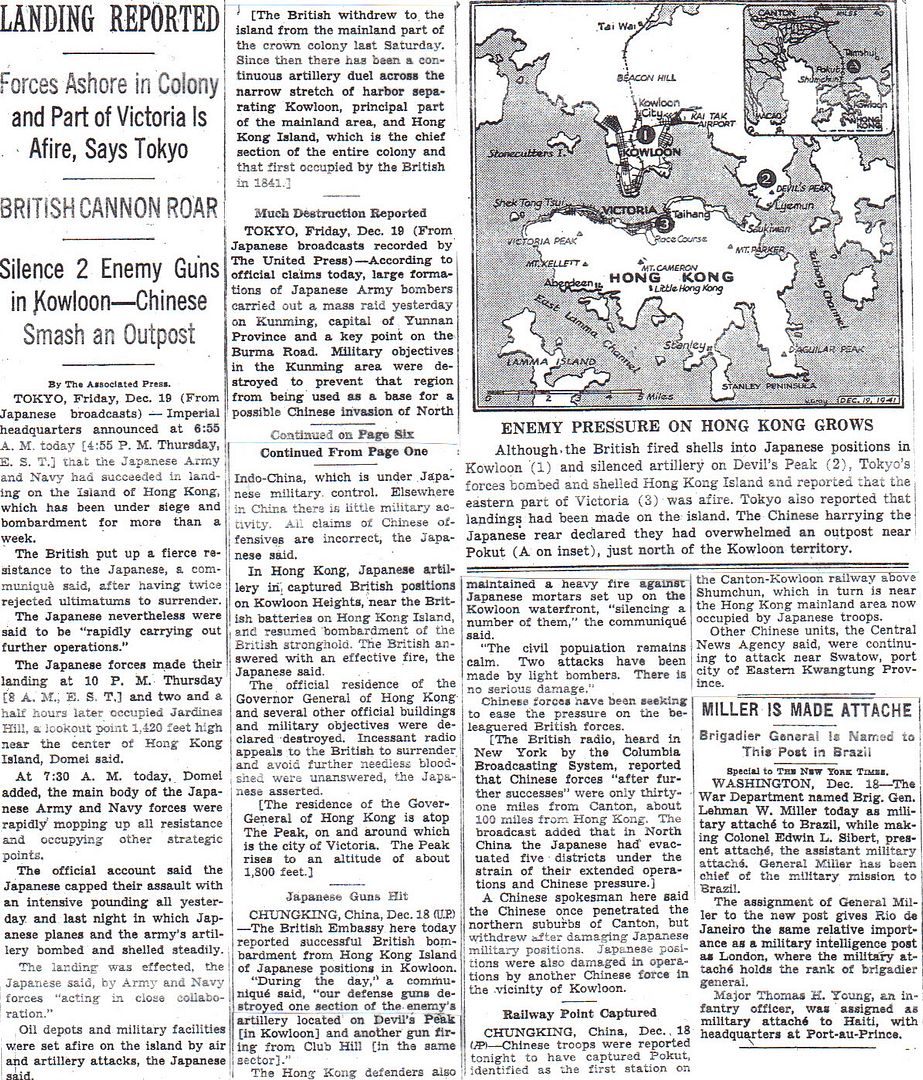

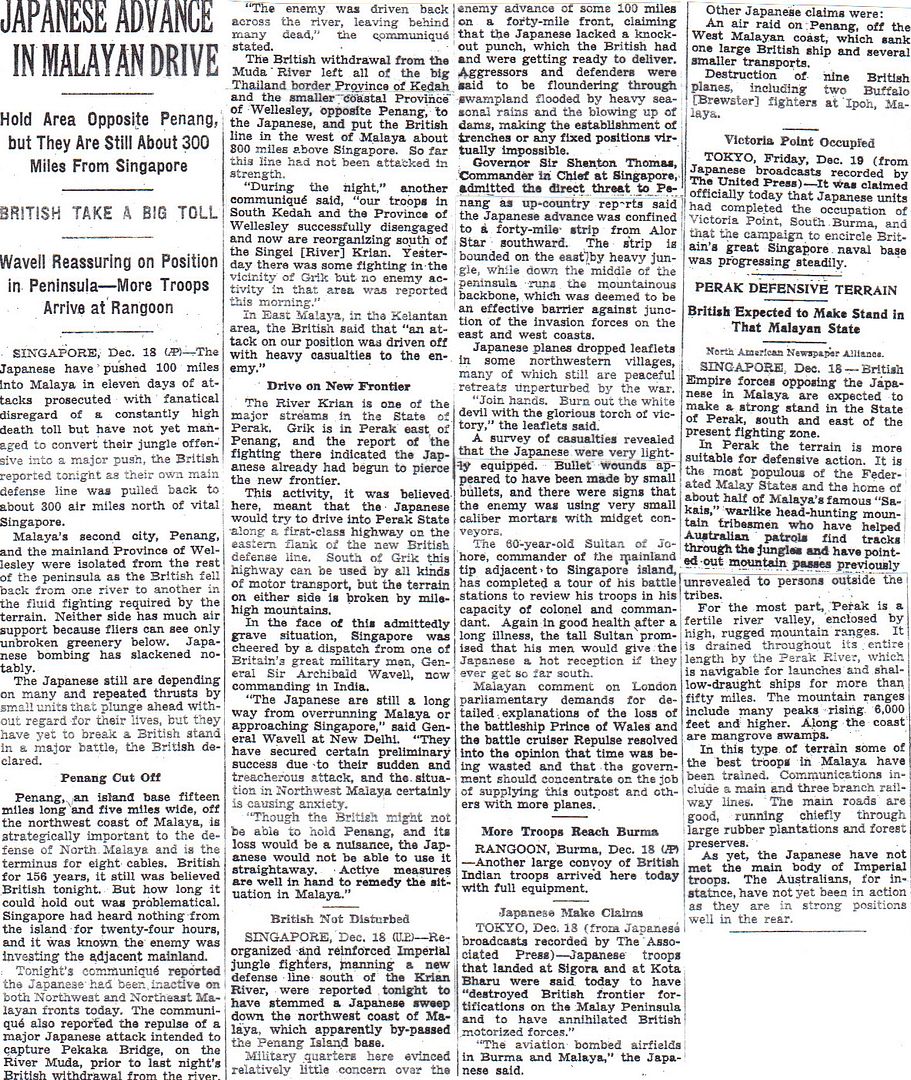
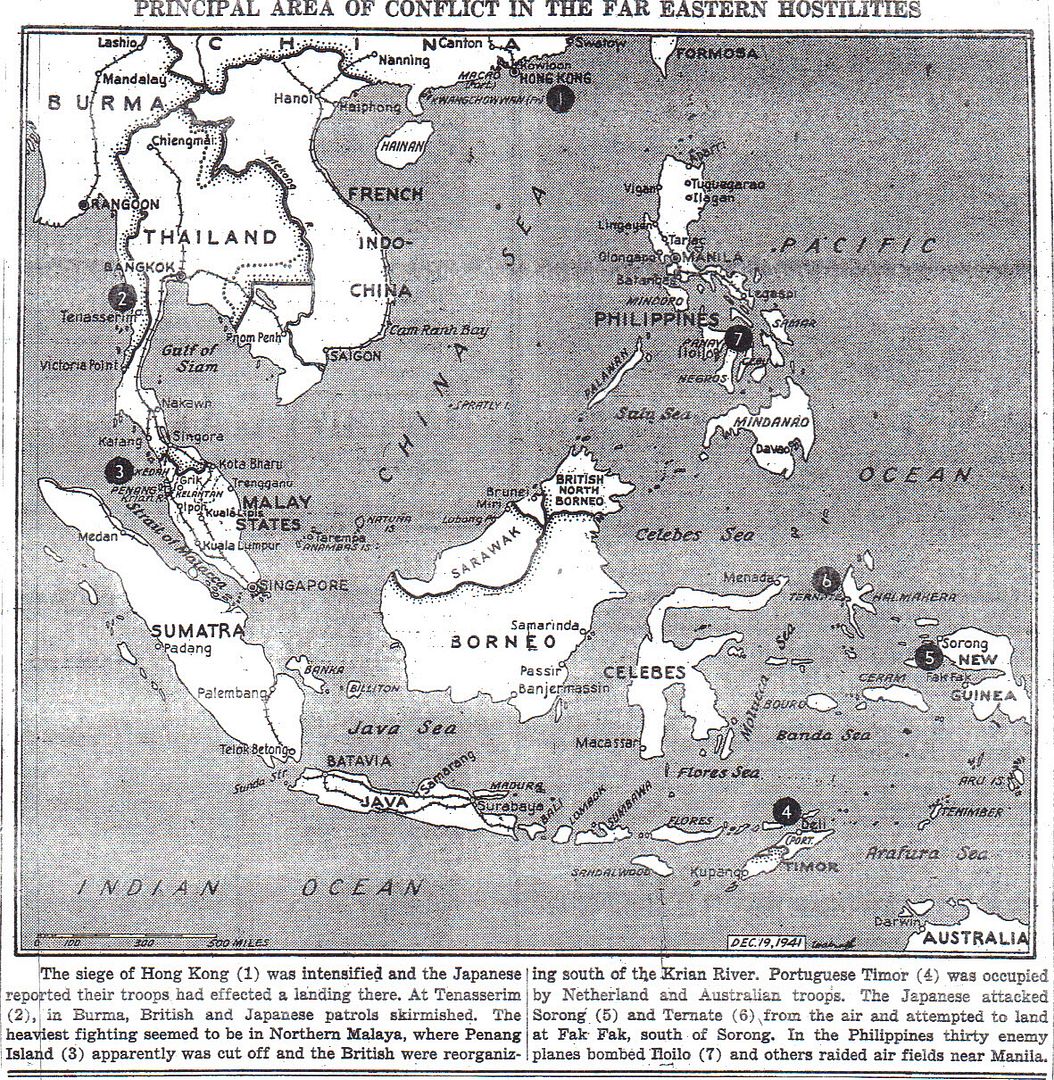
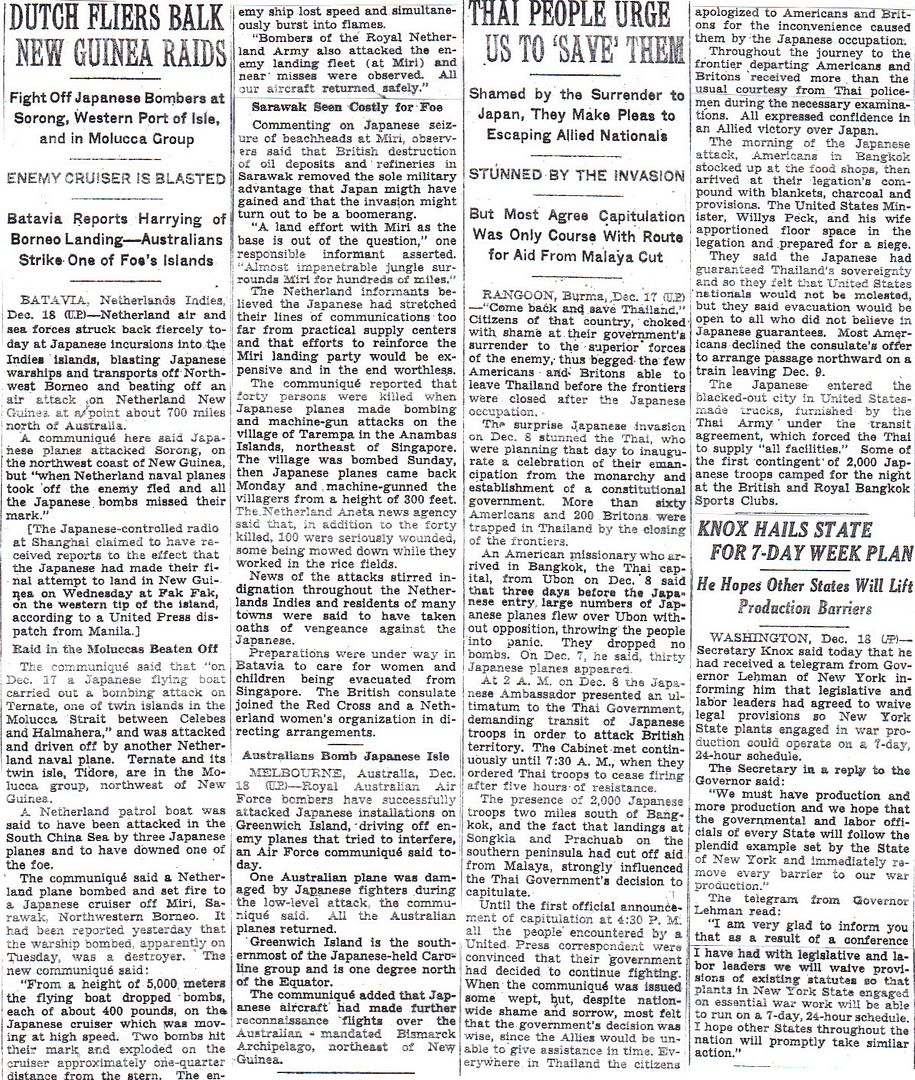

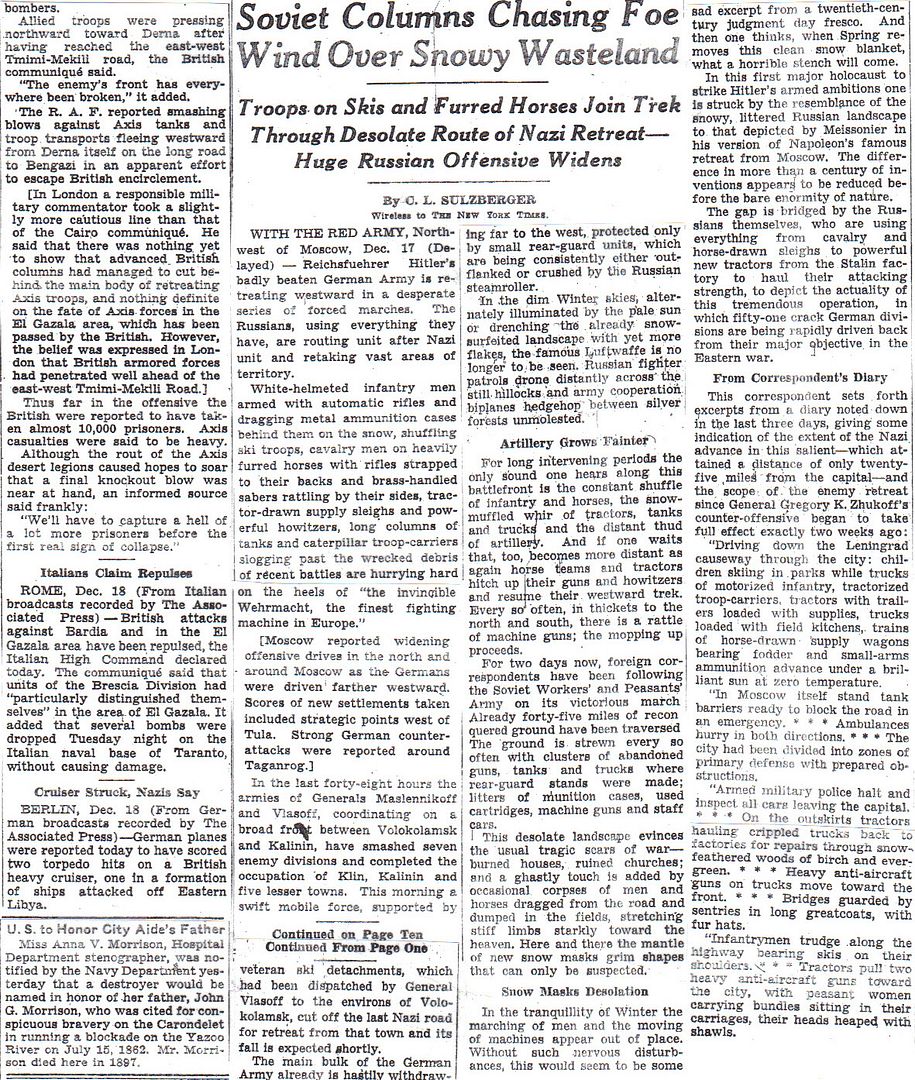


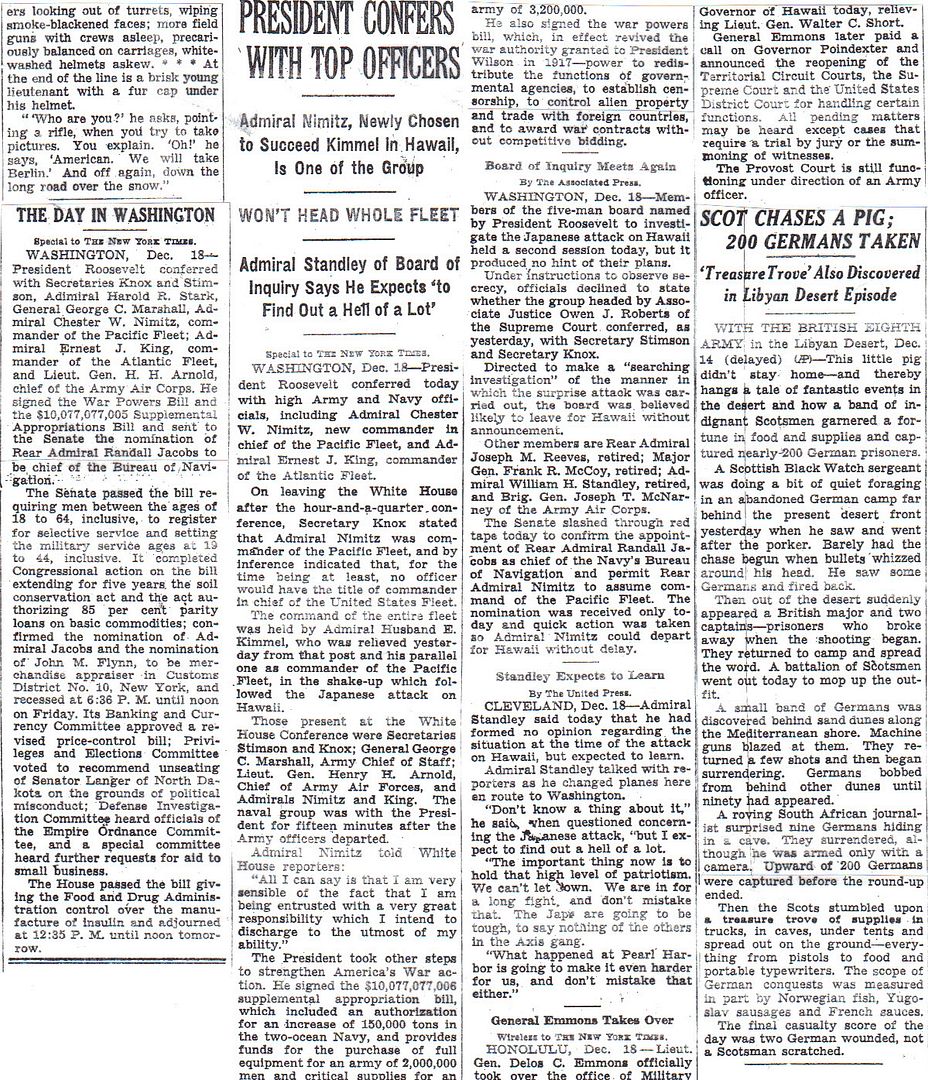

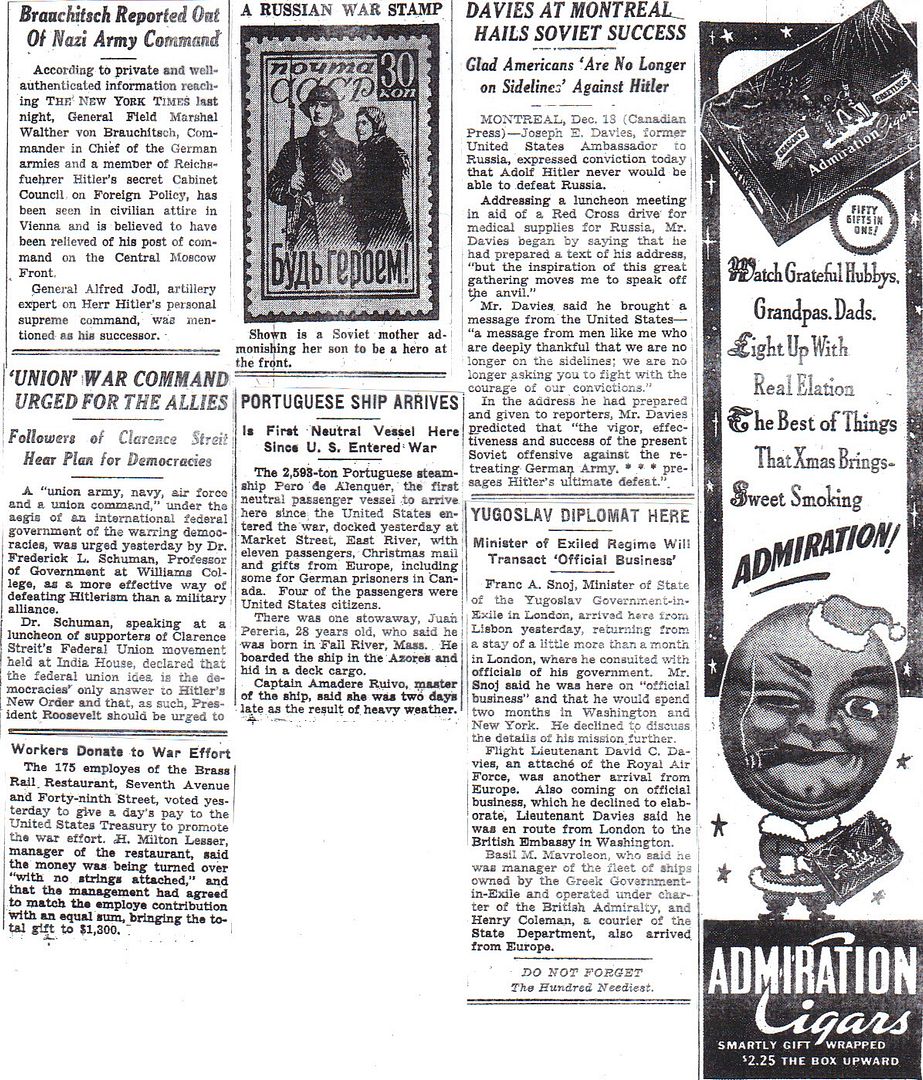
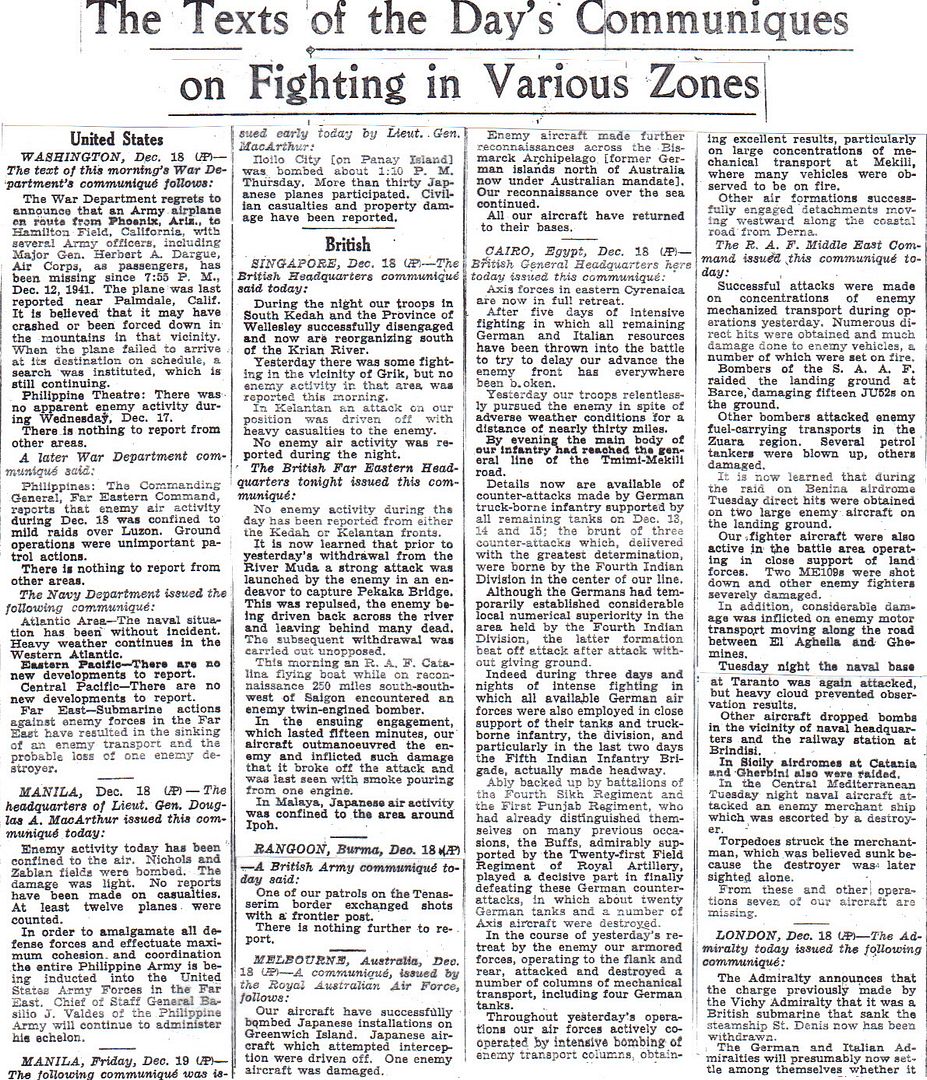
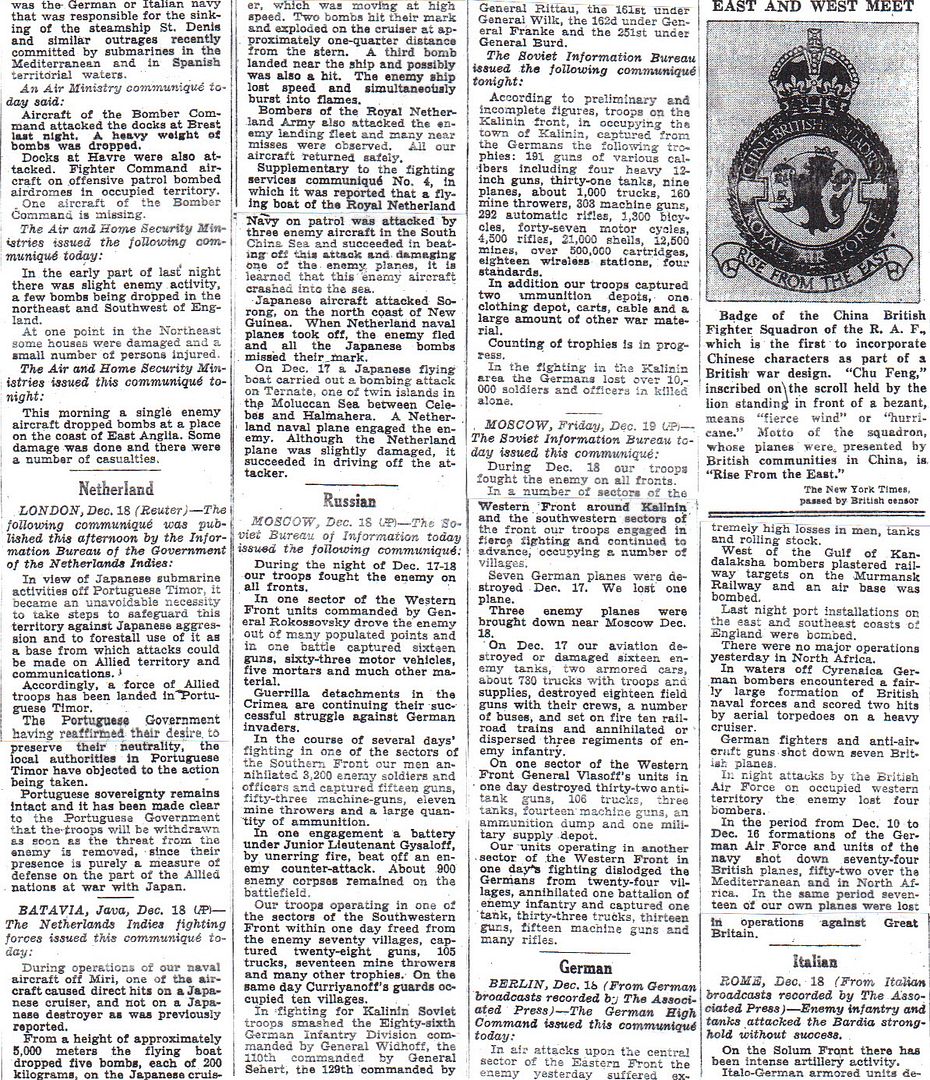

http://www.onwar.com/chrono/1941/dec41/f19dec41.htm
German army attacking Sevastopol
Friday, December 19, 1941 www.onwar.com
In Berlin... Hitler formally removes Brauchitsch as Commander in Chief of the German Army, taking the position himself.
On Eastern Front... Germans continue the attack on Sevastopol, Soviets bring 14,000 men and supplies into the area as reinforcements.
In the Philippines... Japanese land 500 men from the 56th Infantry Regiment near Davao on Mindanao.
http://homepage.ntlworld.com/andrew.etherington/month/thismonth/19.htm
December 19th, 1941
UNITED KINGDOM: Some 200 troops watched the heir to the throne and her sister perform in a royal pantomime of Cinderella today. The show, “somewhere in England”, was in aid of the Royal Household wool fund.
Margaret Rose was the star as a pretty little Cinders, while Princess Elizabeth was her dashing Prince Charming. Accompanied by a military orchestra, the princesses sang many of the old favourites, inviting the audience to join in the choruses. The pumpkin-turned-carriage was a sedan chair used by Queen Anne.
The rest of the cast was made up of children from the local village, all of whom had been coached by the local schoolmaster. Buttons, played by the brother of one of Queen Elizabeth’s maids, was singled out for special praise.
Destroyer HMS Stanley (I-73) is sunk by U-574. She has been part of the escort for convoy HG76 from Gibraltar and reported the presence of a U-boat while on station astern of the convoy. Half an hour later U-574 scored a direct hit; HMS Stanley exploded and sank (38° 12’ N.; 17° 23’ W.) with the loss of all but 25 of her crew. Within 12 minutes, however, sloop HMS Stork gained revenge by sinking the submarine near Punta Delgada, by ramming and depth charges; 28 dead and 16 survivors who are picked up.Formerly USS MCCalla (DD_253) she was part of the destroyers-for-bases deal, commissioned into the RN on 12 Oct. 1940. (Ron Babuka)
Vintage submarine HMS H. 31 is lost, cause unknown NW of the coast of Spain. (Alex Gordon)(108)
Minesweeper HMS Seaham commissioned.
Minesweeper HMS Clacton launched.
Light cruiser HMS Newfoundland launched.
Submarine HMS Unruffled launched. (Dave Shirlaw)
GERMANY: Brauchitsch is formally removed as Commander-in-Chief. Hitler assumes the duties. Initial success in leads Hitler to a hypnotic belief in his ability. When the success turns, Hitler remains convinced and therefore believes that the efforts of others is at fault.
ITALY: Benito Mussolini requests German assistance for his hard-pressed troops in Cyrenaica in the form of a Panzer Division and various logistical support. (Jack McKillop)
U.S.S.R.: The German attacks on Sevastopol continue. The Soviets bring in 14,000 reinforcements via sea between today and the 25th.
MEDITERRANEAN SEA: The Royal Navy is reeling from a series of heavy blows which have left senior admiralty figures contemplating total withdrawal from the Mediterranean.
The sinking by a U-boat of the cruiser HMS GALATEA near Alexandria, was the beginning of the present difficulties. Two days later, Axis aircraft attacked the four cruisers and sixteen destroyers escorting the supply ship Breconshire on one of her many trips to Malta.
Yesterday evening the convoy ran straight into an enemy convoy heading for Benghazi. The Italians opened fire, but beat a retreat when the British mounted a counter-attack. Tragedy struck early this morning after the Breconshire had been delivered to Malta: the escorts sailed into a minefield. The cruiser HMS NEPTUNE is mined 20 miles north of Tripoli at 33 15N, 33 30E, Neptune sets off four mines, and other ships attempting rescue are also mined, the destroyer HMS KANDAHAR’s stern has been blown off, and the cruisers HMS PENELOPE and HMS AURORA have been damaged. Consequently there are 763 casualties and just one survivor of the sinking, Able Seaman (later Petty Officer) Norman Walton (January 15, 1921 - April 20, 2005). The loss of Neptune occurred on the night of December 19. Commanded by Captain Rory O’Conor, she was leading Force K, a cruiser raiding squadron sent to intercept and destroy an important Italian convoy carrying Panzer tanks, troops and supplies to Tripoli. Having become trapped in a minefield 12 miles offshore, Neptune struck four mines in three hours and sank with the loss of 764 officers and men. Thanks to his courage, tenacity and supreme physical fitness, Able Seaman Walton, then aged 20, survived three days in the water and two on a raft before being picked up by an Italian torpedo boat; after 15 months in Italian PoW camps, he was released in 1943. Walton later gave a dramatic account of the sinking: “We had been at action stations since 8pm, when soon after midnight there was an explosion off our starboard bow. The captain stopped engines and went astern but we hit another mine, blowing the screws and most of the stern away. Then we were hit abaft the funnel. We were ordered up top and had a bad list to port and were down in the stern. The destroyer HMS Kandahar came up to take us in tow. “With seven others, I was asked to go forward to help with the tow, but Kandahar then hit a mine and slewed off. Then we hit a fourth mine and we were lifted up and dropped back again. I got the Petty Officer off the forecastle from beneath the anchor chain but he had broken his back. Four of us - Price, Middleton, Quinn and me - climbed down the anchor. They jumped in, but I wanted somewhere to swim to, not just float around, and when I saw a Carley raft I jumped in and swam to it. “I took the tow rope back to Middleton, who had no lifejacket, and when we got back to the raft it was crowded - about 30 people on and around it. We saw the ship capsize and sink, and gave her a cheer as she went down. We picked up Captain O’Conor, who was clinging to what looked like an anchor buoy, and he and three other officers finished up on a cork raft attached to ours. The sea was thick with oil and most of us had swallowed a lot of it. A few died around us that night and at daylight there were 16 of us left. The weather was pretty rough, and two officers tried to swim towards the Kandahar, but they never made it.” Since there was no room for him on the raft, Walton simply hung on to it - periodically swimming around it in circles in order to keep warm. “By the fourth day there were only four of us left, including the captain, who died in my arms that night. I was in the water for three days before being able to find room aboard the raft. Most of the lads just gave up the ghost, but I was very fit because of playing so much sport and this is probably why I survived. “I had a smashed leg, and by Christmas Eve on the fifth day there was only Price and myself left. I saw an aircraft, waved to it and an hour later an Italian torpedo boat came alongside and threw me a line. I collapsed when I got on board and woke up on Christmas Day in a Tripoli hospital. They told me Price was dead.” When he was picked up, Walton found that the oil in the water had temporarily blinded him: “On Boxing Day I got my sight back and looked in a mirror. My tongue was swollen to twice its size and my nose spread across my face, which was black from the oil and from exposure. Still, apart from my broken leg I was almost back to normal by New Year’s Day, when I was put on a ship bound for Italy full of German and Italian troops going on leave.” (Telegraph Group Limited)
After the war Norman became a professional boxer, fighting under the name of Patsy Dodds, although he still fought bare-knuckle and at fairgrounds. One of the other middleweights he fought was my father, John Thomas Etherington. (Don’t know who won though!)
(Alex Gordon)(108)
LIBYA: Rommel’s forces continue their retreat in Cyrenaica.
Allied troops of the 4th Indian Division today added Derna to the list of towns captured since the 8th Army launched Operation Crusader barely a month ago. Rommel signalled the retreat on 16 December after the Allies attacked his defensive line at Gazala.
A counter-attack by Panzers had bought time, but only at a price: Rommel was left with fewer than 40 tanks for the Afrika Korps against nearly 200 for the 8th Army. He decided to move a long way back - into Cyrenaica - in order to await reinforcements from a secure position. By the time Britain’s 4th Armoured Brigade began the pursuit, Rommel and his Italian allies were well on their way.
The Afrika Korps and the Italian Mobile Corps are heading west by an inland desert route, while the Italian infantry divisions have marched along the coast road. Like the vanquished, the British are also running short of supplies: a large proportion of their forces is in danger of being stalled for lack of petrol. In fact, both sides are weary after a month of blood fighting, never more so than at Sidi Rezegh and at Tobruk, the main prize of this campaign to date.
EGYPT: The battleships HMS Valiant and HMS Queen Elizabeth, while moored in the port of Alexandria, are critically damaged by explosions under their keels planted by Human Torpedo’s operated by Italian frogmen of the Decima Flottiglia MAS. The damage is so great that these two ships were deemed unseaworthy. Along with the battleships, the tanker SS Sagona and the destroyer HMS Jervis are also severely damaged. Two Italian frogmen are captured, Lt. Luigi Durand de la Penne and Lt Bianchi. They refused to divulge any information until moments before the explosion (because they were being interrogated right above the area of the keel where the explosion was to occur). This attack, which neutralized the ability of the British to oppose the Italian Regia Marina with its battleships, allowed deeply needed convoys to supply Axis forces in Africa. (Jack McKillop)
BURMA: The Japanese overrun Bokpyin, a village about 100 miles (161 kilometres) north of Victoria Point. A controversy. known as the “Tulsa” Incident, arises as a U.S. officer asks the Government of Burma to Impound lend-lease material at Rangoon (a valuable part of which is loaded on the SS Tulsa in the harbor), pending a decision on its use. At the suggestion of the senior Chinese representative in Burma, a committee is subsequently formed to determine the division of supplies. (Jack McKillop)
MALAYA: The Japanese are active against the right flank of the Krian River line; on the Grik road, the Japanese frustrates the efforts of the Indian 3 Corps to recover lost ground. RAF fighters based at Ipoh are forced to withdraw to Kuala Lumpur. The Indian 9th Division continues their withdrawal southward in eastern Malaya and abandons the Kuala Krai railhead. (Jack McKillop)
COMMONWEALTH OF THE PHILIPPINES: On Luzon, the Japanese Legaspi detachment reaches Sipoco and is reported to be pushing toward Daet. (Jack McKillop)
On Mindanao, two enemy task forces from the Palau Islands, totaling about 5,000 men, arrive off Davao during the night of 19/20 December. Enemy aircraft discover and attack Del Monte airfield. (Jack McKillop)
HONG KONG: Japanese troops surround the headquarters of Canadian Brigadier J. K. Lawson at Wong Nei Chong Gap on Hong Kong Island. Lawson is killed in attempted breakout becoming the first Canadian General killed in WWII. (Jack McKillop)
Canadian Sergeant Major (WOII) John Robert Osborn (b. 1899) of The Winnepeg Grenadiers dies during an attempt to recapture Mount Butler. Osborn Lawson falls on a grenade to save others in the company and is posthumously awarded the Victoria Cross. (Jack McKillop)
AUSTRALIA: The air echelon of the USAAF’s 93d Bombardment Squadron (Heavy), 19th Bombardment Group (Heavy) transfers from Clark Field, Luzon to Batchelor Field near Darwin, Northern Territory, with B-17s. The ground echelon is attached to the 5th Interceptor Command (Provisional) and will fight as infantry on Luzon and Mindanao Islands in the Philippines. (Jack McKillop)
Minesweeper HMAS Townsville commissioned. (Dave Shirlaw)
TERRITORY OF HAWAII: The USN’s Task Force 8 (TF 8) (Vice Admiral William F. Halsey, Jr.), formed around the aircraft carrier USS Enterprise (CV-6), heavy cruisers, and destroyers, sails from Pearl Harbor proceeding to waters west of Johnston Island and south of Midway to cover TF 11 and TF 14 operations. (TF 11 is en route to the Marshall Islands while TF 14 is en route to Wake Island.) Destroyer USS Craven (DD-382), in TF 8, is damaged by heavy sea soon after departure, however, and returns to Pearl for repairs. (Jack McKillop)
WAKE ISLAND: Japanese Mitsubishi G3M2, Navy Type 96 Attack Bombers (given the Allied Code Name “Nell” in 1942) assigned to the Chitose Kokutai (Chitose Naval Air Corps), bomb Wake Island, targeting installations on Wake and Peale islets. (Jack McKillop)
CANADA: Algerine-class minesweepers HMS Melita, Octavia, Persian, Postillion, Scorpion (ex-HMCS Sole Bay), Thisbe, Truelove, Welfare ordered in Canada. (Dave Shirlaw)
U.S.A.: The US Selective Service (draft) Act is amended requiring the registration of all males 18-64. The age for those subject to military service is 20-44.
An additional 2.4 million men will be liable for conscription.
Other powers granted by Congress to the president include press censorship; control of an estimated $7 billion of enemy property in the United States; and that to let contracts without competitive tendering.
The president is authorised to re-organize the executive branch of the government in any way that he pleases to prosecute the war more effectively.
The executive news editor of the Associated Press, Byron Price, aged 50, has been appointed “director of censorship”. The president has appointed Mr Justice Owen Roberts of the Supreme Court as chairman of the board of inquiry into American unpreparedness for the Pearl Harbor raid.
The USAAF’s 1st Air Force is reassigned from the Air Force Combat Command to the Eastern Theater of Operations, US Army which is subsequently redesignated the Eastern defence Command. (Jack McKillop)
Escort carrier USS Altamaha laid down.
Destroyer USS Beale laid down.
Destroyer USS Bailey launched. (Dave Shirlaw)
MEXICO: Mexico breaks diplomatic relations with Hungary. (Jack McKillop)
NICARAGUA: Nicaragua declares war on Bulgaria, Hungary and Romania. (Jack McKillop)
COLUMBIA: Colombia breaks relations with Germany and Italy. (Jack McKillop)
ATLANTIC OCEAN: U-108 sank SS Ruckinge in Convoy HG-76.
U-652 sank SS Varlaam Avanesov. (Dave Shirlaw)
I hope you are all following Hanson W. Baldwin' four-part series on the attack and the commission just formed to investigate it. It may not shed any new light but it is a good preview of the debate that continues to this day and an interesting look at the conventional wisdom as of 12/18/41.
Saw a WWII submarine bell in a bar resrurant in Tanjay, Philippines, there’s an inscription with the name...but I was a little drunk..cant remember the subs name.
A retired navy sailor pawned it to a Filipina lady who owned the place.
HMS Barham sunk 11/25/41
HMS Prince of Wales sunk 12/10/41
HMS Repulse sunk 12/10/41
HMS Queen Elizabeth sunk 12/19/41
HMS Valiant sunk 12/19/41
The first four were lost, the last two were sunk at their docks in Alexandria. After their loss the British had no capital ships in the Mediterranean and no longer had superiority over the Italian navy. Since the two ships settled to the bottom, but their decks were not awash, the British acted as if the ships were still combat ready in order to deceive any Italian spies active in Alexandria. Both ships were re-floated after several months and departed for repairs, one to the U.S., the other to South Africa.
As the list above shows, November/December 1941 was a bad two months for the Royal Navy, and you can make the case that the Royal Navy finally lost its position as “mistress of the seas”, held for over two centuries, with the sinking of these 6 ships.
It would take a over a year of brutal combat with the Imperial Japanese Navy before the United States Navy would conclusively take the Royal Navy's place as ruler of the seas.
The press plays up all the good news it can get?
Disclaimer: Opinions posted on Free Republic are those of the individual posters and do not necessarily represent the opinion of Free Republic or its management. All materials posted herein are protected by copyright law and the exemption for fair use of copyrighted works.